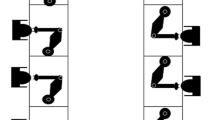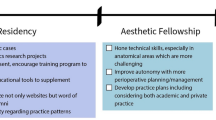Abstract
Background
Microsurgical techniques are an important part of clinical and experimental research. In this paper, we present our survey of Italian microsurgery training and our experience of the importance of a free access microsurgical laboratory.
Methods
A cross-sectional observational study was performed by administering a questionnaire regarding the current situation about microsurgical training in Italian Plastic, Reconstructive and Aesthetic Surgery residency programs. A case–control study was performed on 12 residents divided into four groups of attendance to the microlaboratory.
Results
Two hundred and seventy-six trainees replied to the questionnaire, representing 94.7% of residents enrolled in the Italian Society of Plastic, Reconstructive-Regenerative and Aesthetic Surgery (SICPRE). Only 25% of Italian residency locations own an environment dedicated to microsurgical training. All residents agreed to the importance of a free access microsurgical laboratory in their resident program. We verify a higher improvement in microsurgical anastomosis in resident who performed a more assiduous attendance to microsurgical laboratory.
Conclusions
Microsurgical skills are fundamental in becoming a complete plastic surgery specialist. It is important to invest in a microsurgical training in all residency programs. We consider that our experience could be useful to spur other residency institutions to invest in microsurgical training and maybe to create a microsurgical training network.
Level of evidence: Not gradable
Similar content being viewed by others
References
Karam MD, Pedowitz RA, Natividad H, Murray J, Marsh JL (2013) Current and future use of surgical skills training laboratories in orthopaedic resident education: a national survey. J Bone Jt Surg 95(1). https://doi.org/10.2106/JBJS.L.00177
Mazen AJ, Becker F, Palmes D, Stöppeler S, Bahde R, Kebschull L, Spiegel H, Hölzen JP (2021) Microsurgical training course for clinicians and scientists: a 10-year experience at the Münster University Hospital uratli. BMC Med Educ 21:295. https://doi.org/10.1186/s12909-021-02737-1
Klein I, Steger U, Timmermann W, Thiede A, Gassel HJ (2003) Microsurgical training course for clinicians and scientists at a German University hospital: a 10-year experience. Microsurgery 23(5):461–465
Shurey S, Akelina Y, Legagneux J, Malzone G, Jiga L, Ghanem AM (2014) The rat model in microsurgery education: classical exercises and new horizons. Arch Plast Surg 41(03):201–208
Green CJ (1987) Microsurgery in the clinic and laboratory. Lab Anim 21(01):1–10
Ortiz R, Sood RF, Wilkens S, Gottlieb R, Chen NC, Eberlin KR (2019) Longitudinal microsurgery laboratory training during hand surgery fellowship. J Reconstr Microsurg. https://doi.org/10.1055/s-0039-1691784
Tos P, Pedrazzini A (2015) Manuale di Microchirurgia dalle tecniche di base a quelle avanzate, ed. Società Italiana di Microchirurgia, 1st edition, ISBN: 978–88–97162–41–4 Timeo Editore, Bologna
Alzakri A, Al-Rajeh M, Liverneaux PA, Facca S (2014) État des lieux de l’enseignement des techniques microchirurgicales en France et à l’étranger [Courses in microsurgical techniques in France and abroad]. Chir Main 33(3):219–23. https://doi.org/10.1016/j.main.2014.03.006. (French)
Hirche C, Megerle K, Heitmann C et al (2020) Konsensus der Deutschsprachigen Arbeitsgemeinschaft für Mikrochirurgie der peripheren Nerven und Gefäße (DAM) für Mindeststandards mikrochirurgischer Trainings- und Übungskurse zur Vergabe eines Qualitätssiegels [Consensus of the German-Speaking Society for Microsurgery of Peripheral Nerves and Vessels (DAM) on minimum standards for microsurgical training courses and accreditation - Minimum Standards for Microsurgical Training Courses and Accreditation]. Handchir Mikrochir Plast Chir 52(2):135–139. https://doi.org/10.1055/a-1017-3688. (German)
Paladino JR, Gasteratos K, Akelina Y, Marshall B, Papazoglou LG, Strauch RJ (2021) The benefits of expert instruction in microsurgery courses. J Reconstr Microsurg 37(2):143–153. https://doi.org/10.1055/s-0040-1715910
Volovici V, Dammers R, Lawton MT, Dirven CMF, Ketelaar T, Lanzino G, Zamfirescu DG (2019) The flower petal training system in microsurgery: validation of a training model using a randomized controlled trial. Ann Plast Surg 83(6):697–701. https://doi.org/10.1097/SAP.0000000000001914
Oliveira MM, Quittes L, Costa PHV et al (2022) Computer vision coaching microsurgical laboratory training: PRIME (Proficiency Index in Microsurgical Education) proof of concept. Neurosurg Rev 45(2):1601–1606. https://doi.org/10.1007/s10143-021-01663-6
Dave A, Singhal M, Tiwari R, Chauhan S, De M (2022) Effectiveness of a microsurgery training program using a chicken wing model. J Plast Surg Hand Surg 56(4):191–197. https://doi.org/10.1080/2000656X.2021.1953043
Atkins JL, Kalu PU, Lannon DA, Green CJ, Butler PE (2005) Training in microsurgical skills: does course-based learning deliver? Micro- surgery 25(06):481–485
Perez-Abadia G, Janko M, Pindur L et al (2017) Frankfurt microsurgery course: the first 175 trainees. Eur J Trauma Emerg Surg 43(03):377–386
Ali S (2018) Basic microvascular anastomosis simulation hub microsur- gery course: an innovative competency-based approach to micro- surgical training for early year’s plastic surgery trainees. Ann Plast Surg 80(04):314–315
Tsuda S, Mohsin A, Jones D (2015) Financing a simulation center. Surg Clin North Am 95(4):791–800. https://doi.org/10.1016/j.suc.2015.03.002
Khachatryan A, Arakelyan G, Tevosyan A et al (2021) How to organize affordable microsurgical training laboratory: optimal price-quality solution. Plast Reconstr Surg Glob Open 9(9):e3791. https://doi.org/10.1097/GOX.0000000000003791
Lakhiani C, Fisher SM, Janhofer DE, Song DH (2018) Ergonomics in microsurgery. J Surg Oncol 118(5):840–844. https://doi.org/10.1002/jso.25197
Ahluwalia T, Gidwani S, Douglass K (2021) Effectiveness of remote practical boards and telesimulation for the evaluation of emergency medicine trainees in India. AEM Educ Train 5(4):e10686. https://doi.org/10.1002/aet2.10686
Hayden EM, Khatri A, Kelly HR, Yager PH, Salazar GM (2018) Mannequin-based telesimulation: increasing access to simulation-based education. Acad Emerg Med 25(2):144–147. https://doi.org/10.1111/acem.13299
Nelsen BR, Chen YK, Lasic M, Bader AM, Arriaga AF (2020) Advances in anesthesia education: increasing access and collaboration in medical education, from E-learning to telesimulation. Curr Opin Anaesthesiol 33(6):800–807. https://doi.org/10.1097/ACO.0000000000000931
Funding
The authors have nothing to disclose. No funding was received for this article.
Author information
Authors and Affiliations
Corresponding author
Ethics declarations
Ethics approval
No ethical approval was necessary due to the observational nature of the study. This article does not contain any clinical studies involving human participants or animals performed by any of the authors.
Consent to participate
The participants consented to participate and share their data.
Competing interests
Federico De Maria, Valentina Pinto, Massimo Pinelli, Filippo Taccioli, Claudio Gio Francesco Blessent, Caterina Marra, Gian Piero Mantovani, and Giorgio De Santis declare no conflict of interest.
Additional information
Publisher's Note
Springer Nature remains neutral with regard to jurisdictional claims in published maps and institutional affiliations.
Federico De Maria and Valentina Pinto contributed equally to the study and should be accounted as first authors.
Rights and permissions
Springer Nature or its licensor (e.g. a society or other partner) holds exclusive rights to this article under a publishing agreement with the author(s) or other rightsholder(s); author self-archiving of the accepted manuscript version of this article is solely governed by the terms of such publishing agreement and applicable law.
About this article
Cite this article
De Maria, F., Pinto, V., Pinelli, M. et al. Microsurgery courses vs continuous microsurgery laboratory training: an Italian experience. Eur J Plast Surg 46, 1383–1388 (2023). https://doi.org/10.1007/s00238-023-02132-7
Received:
Accepted:
Published:
Issue Date:
DOI: https://doi.org/10.1007/s00238-023-02132-7




